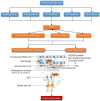Oxidative Stress and Vascular Dysfunction in the Retina: Therapeutic Strategies
- PMID: 32824523
- PMCID: PMC7465265
- DOI: 10.3390/antiox9080761
Oxidative Stress and Vascular Dysfunction in the Retina: Therapeutic Strategies
Abstract
Many retinal diseases, such as diabetic retinopathy, glaucoma, and age-related macular (AMD) degeneration, are associated with elevated reactive oxygen species (ROS) levels. ROS are important intracellular signaling molecules that regulate numerous physiological actions, including vascular reactivity and neuron function. However, excessive ROS formation has been linked to vascular endothelial dysfunction, neuron degeneration, and inflammation in the retina. ROS can directly modify cellular molecules and impair their function. Moreover, ROS can stimulate the production of inflammatory cytokines, such as tumor necrosis factor-alpha (TNF-α) and interleukin-6 (IL-6) causing inflammation and cell death. However, there are various compounds with direct or indirect antioxidant activity that have been used to reduce ROS accumulation in animal models and humans. In this review, we report on the physiological and pathophysiological role of ROS in the retina with a special focus on the vascular system. Moreover, we present therapeutic approaches for individual retinal diseases targeting retinal signaling pathways involving ROS.
Keywords: oxidative stress; reactive oxygen species; retinal disease; vascular endothelium.
Conflict of interest statement
The authors declare no conflict of interest.
Figures



References
Publication types
LinkOut - more resources
Full Text Sources

